With a gruelling schedule and strict technical requirements, including surround-sound elements, Steven Wilson’s recent Hand. Cannot. Erase. world tour was nothing if not ambitious.
Prolific musician, producer, and respected surround-sound mix engineer (to mention but a few of his current activities) Steven Wilson recently wrapped up his 2016 Hand. Cannot. Erase. tour. Throughout the year the tour featured legs in Europe, Canada, the USA, Central and South America, a return to Europe, Asia, New Zealand and Australia, a return to the USA, and a final couple of dates in India — a busy year promoting his latest full-length album for sure! Sound On Sound spent a day with Wilson’s sound engineer Ian Bond, at the tour’s recent Kansas City show, to see what goes into the audio production for this type of tour, and how he makes the show sound the best it can for every audience.
Categorising Wilson’s musical style is difficult, simply because he traverses so many different styles. Hand. Cannot. Erase. and the subsequent mini-album 4 1/2 include elements of rock, crossover and progressive rock, ambient, metal, and even a hint of jazz. The band are amazingly talented musicians using musical and production technology to deliver virtuosic, great-sounding and great-looking shows to loyal fans. On this leg the tour was filling venues with capacities of around two to three thousand. Given the sold-out dates, and some two-night engagements in certain venues, there’s no doubt Wilson’s popularity is continuing to grow.
The Wilson On The Bus...
The presentation of the live show is of paramount importance to Wilson, the band, and the crew. To aid this, throughout Europe they carry all sound, lights and video equipment with them — equipment they are familiar with, know works properly, and meets their specifications to guarantee the best production possible. In the USA (and fly-in shows elsewhere) logistics have meant more ‘house’ and locally supplied equipment, but the goal for future touring cycles is to also carry all production equipment throughout the USA.
 FOH and monitor sound engineer Ian Bond at his Midas Pro 2 during soundcheck.Using locally provided main speaker systems in each city has downsides in the form of ‘unknowns’ — new venues the band haven’t performed in before and PA systems of varying quality make it more of a challenge to get the FOH sound together each night than if the same speaker system is used night in, night out. This latest American leg of the tour used just two vehicles: the band and crew in a sleeper bus, with musical and stage equipment, the FOH mixer and monitor systems in a single semi-tractor/trailer.
FOH and monitor sound engineer Ian Bond at his Midas Pro 2 during soundcheck.Using locally provided main speaker systems in each city has downsides in the form of ‘unknowns’ — new venues the band haven’t performed in before and PA systems of varying quality make it more of a challenge to get the FOH sound together each night than if the same speaker system is used night in, night out. This latest American leg of the tour used just two vehicles: the band and crew in a sleeper bus, with musical and stage equipment, the FOH mixer and monitor systems in a single semi-tractor/trailer.
Using a digital mixer means that huge mixing consoles and multiple racks of processors are not necessary, so the footprint of the FOH gear in the venue and trailer is relatively small. Bond explains: “Since touring with Porcupine Tree in 1999 I’ve been an analogue fan. I’d love to be mixing on a [Midas] XL4, but logistics mean that’s rarely going to happen anymore. I’m using a [digital] Midas Pro 2. It sounds great, but most importantly, it sounds like a Midas — it must sound right, and to me it does.” Bond is mixing both FOH and monitors from that single 64-in/24-out console (56 inputs plus 8 mono returns), and it’s almost maxed out with only three inputs and two outputs free (those few spare inputs are used for the opening act if there is one).
 Aggressive kick-drum EQ is applied to each of the kick mics. In this case, boom and weight is added to the SM91 inside the drum.That’s a lot of responsibility for a single person, particularly when translating such intricate, dynamic music to the live concert environment. So how does he approach mixing songs Wilson’s loyal fans are intimately familiar with, while keeping all the musicians happy at the same time?
Aggressive kick-drum EQ is applied to each of the kick mics. In this case, boom and weight is added to the SM91 inside the drum.That’s a lot of responsibility for a single person, particularly when translating such intricate, dynamic music to the live concert environment. So how does he approach mixing songs Wilson’s loyal fans are intimately familiar with, while keeping all the musicians happy at the same time?
“The band are different live. It’s a different dynamic to a studio recording, but these are incredible musicians who recorded live performances in the studio. The songs are already there, live on the stage. It’s my job to follow the band, not to change them. The musician’s performances produce the complexities in the sound, the textures and dynamics. Most of my job is balancing the different elements and scaling the sound up to fill the venue.” More on the monitor mixes later...
Readers who are familiar with any of Steven Wilson’s albums (and most of his other projects) will know that they are sonically very complex, exploring vastly different soundscapes not only from song to song, but also within longer song forms. This might lead one to assume that Bond would be busy recreating those different studio stylisations for each song and for sections of songs, but as he explained earlier, most of those creative elements are produced directly by the musicians on stage.
“My mix is fairly effects light. I don’t use many effects. The musicians create the sound, and if the sound is put into the system well on stage, it should come out of the system well for the audience. I add some drum reverb, and a variety of delays on Steven’s vocals in a few places. Most of the effects are in the mixer; the only outboard is a Line 6 Pod for some crazy vocal distortion to emulate the album in a couple of songs. I don’t use any reverb on the vocals, except in ‘The Raven’.”
Miking Up
Capturing the on-stage sound is an arsenal of Bond’s personal microphones. Audix mics became the mainstay of his collection years ago when working with Wilson’s Porcupine Tree project: “I needed a vocal mic that would allow Steven’s vocals to be heard over Porcupine Tree’s stage volume; one that would be resistant to feedback and not pick up as much spill as other vocal mics. Since trying the OM7 I’ve stuck with it, using it on most of the vocals on this stage. It’s specifically designed as a low-output mic requiring a lot of preamp gain, so the singer has to really stay ‘on’ the mic, and Steven does. All the Audix mics have proved rugged and reliable, surviving flying tens of thousands of miles each year.” Other mics include a Shure KSM32 large-diaphragm cardioid condenser and an Audix i5 cardioid dynamic mic, each on different cones of both Wilson’s BadCat guitar cabinet and Dave Kilminster’s Brunetti cabinet (see ‘Pedal Power’ box).
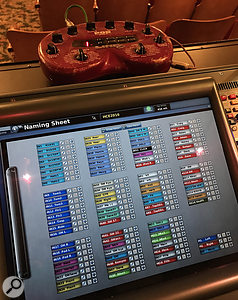 The only outboard, a Line 6 Pod, sits atop the FOH and monitor mixer, the pictured screen showing the inputs.The FOH footprint of the show is just the Midas Pro 2 mixer and the Pod resting on top of it. Traditional ‘DriveRack’-style processing (system and feedback EQ) and channel dynamics and effects processing are taken care of by the mixer, and Bond uses a delay on the outputs to bring the sound of the entire FOH speaker system in time and phase with Wilson’s guitar amp — a 10 to 15 ms delay, depending on the distance from the main speaker arrays to the cabinet. This helps reduce comb-filtering in the guitar sound, and also solidifies the timbre and focus of the drum sound as the natural stage volume combines with the miked sound from the PA system. This is especially important in small to mid-sized venues, where a significant percentage of the sound the audience hear is directly from the instruments and amplifiers on stage.
The only outboard, a Line 6 Pod, sits atop the FOH and monitor mixer, the pictured screen showing the inputs.The FOH footprint of the show is just the Midas Pro 2 mixer and the Pod resting on top of it. Traditional ‘DriveRack’-style processing (system and feedback EQ) and channel dynamics and effects processing are taken care of by the mixer, and Bond uses a delay on the outputs to bring the sound of the entire FOH speaker system in time and phase with Wilson’s guitar amp — a 10 to 15 ms delay, depending on the distance from the main speaker arrays to the cabinet. This helps reduce comb-filtering in the guitar sound, and also solidifies the timbre and focus of the drum sound as the natural stage volume combines with the miked sound from the PA system. This is especially important in small to mid-sized venues, where a significant percentage of the sound the audience hear is directly from the instruments and amplifiers on stage.
What’s On The Wireless?
A rack containing the I/O for the Pro 2 mixer, and the transmitter boxes for the in-ear monitor systems, sits in the wings. A Midas DL251 (48-in/16-out stage box) handles most of the I/O and conversion for the mixer, and a DL451 handles the excess. Three Cat-5 cables connect these to the mixer at FOH. With the exception of the drummer, who has wired in-ears, each musician’s unique monitor mixes are transmitted by Shure wireless systems via a pair of Professional Wireless antenna combiner/amplifiers and helical antennas.
 The heart of Bond’s touring system: the on-stage mixer I/O and wireless monitor rack.Bond uses helical antennas because, he says, “It’s a real problem when a musician’s receiver belt-pack changes orientation as they move and perform. The polarisation of the transmitted radio waves becomes out of line with the receiver antenna, and the in-ear signal drops out. The helical antenna transmits in all polarisations, so signal will still be received regardless of the angle of the receiver antenna.” These antennae also transmit strong directional signals, further improving signal reliability.
The heart of Bond’s touring system: the on-stage mixer I/O and wireless monitor rack.Bond uses helical antennas because, he says, “It’s a real problem when a musician’s receiver belt-pack changes orientation as they move and perform. The polarisation of the transmitted radio waves becomes out of line with the receiver antenna, and the in-ear signal drops out. The helical antenna transmits in all polarisations, so signal will still be received regardless of the angle of the receiver antenna.” These antennae also transmit strong directional signals, further improving signal reliability.
But no system is immune to problems, particularly radio frequencies: “A couple of weeks ago, something in the wireless frequency spectrum changed between soundcheck and show time. During the show the in-ears just died. No in-ear monitors or click tracks for anyone except the drummer. After some panicked looks and exchanging a few words on stage, the drummer counted off the songs from the click track that he could still hear via his wired in-ears. And they played — just a great band, able to continue the show. Real musicians.”
 One of the two helical transmitter antennae used to improve the signal reliability of the in-ear monitor systems.As mentioned earlier, Bond is mixing both FOH and monitors for this tour, usually a less-than-ideal situation, but he’s done it for many years. A touring show of this nature has production rehearsals before the tour starts, during which each musician’s monitor mix can be dialed in. The Pro 2 digital mixer allows Bond’s mixes and console setup to be stored on a USB memory stick, so all the settings are easily and quickly transferred to whichever Pro 2 console he’s using in a particular territory — in moments he’s up and running without needing extended time to dial in either the monitor or FOH mixes from scratch.
One of the two helical transmitter antennae used to improve the signal reliability of the in-ear monitor systems.As mentioned earlier, Bond is mixing both FOH and monitors for this tour, usually a less-than-ideal situation, but he’s done it for many years. A touring show of this nature has production rehearsals before the tour starts, during which each musician’s monitor mix can be dialed in. The Pro 2 digital mixer allows Bond’s mixes and console setup to be stored on a USB memory stick, so all the settings are easily and quickly transferred to whichever Pro 2 console he’s using in a particular territory — in moments he’s up and running without needing extended time to dial in either the monitor or FOH mixes from scratch.
“I haven’t made any real adjustments to their monitor mixes for several years. Each mix got dialled in, and they’re such good musicians that they don’t need tweaks every time the venue changes. All of the musicians, except Steven, have stereo in-ear monitors,” explains Bond. In-ears don’t interact with, and are not affected by, each venue’s different room acoustics in the same way that wedge monitors would be, so by default present a more consistent mix to each band member. This makes Bond’s job a little easier, and setup and soundcheck quicker. “They have everything in their in-ear mix, with themselves on top. Steven has a pair of wedges with the music mix, and a single mono in-ear with his vocal and click track. All of the band get a click track and vocal cue track in their in-ears.” Various incarnations of this band have been touring since 2011, and Ian Bond still has the channels for musicians and guest musicians not on this specific tour leg saved, just in case they return to the band at some point.
In The Round
Steven Wilson has fast gained a reputation for being a leading surround-sound mix engineer, mixing not only his own projects in 5.1, but also back-catalogue material including albums by Yes, Jethro Tull, XTC and King Crimson — so it made sense to bring some of that surround-sound envelopment to the tour! The size of the venues being played makes this possible (any bigger, and the timing problems and amplitude drop-offs caused by the physics of the larger distances between the front and rear speakers would make it impractical). The tour travelled with three pairs of d&b Y10P full-range passive loudspeakers, so that surround stereo pairs could be set up in the rear of multiple floor and balcony levels. The Y10Ps are small, lightweight, dual 10-inch boxes, with up to an incredible (given their size and weight) 137dB SPL output when coupled with matched d&b amplifiers. Signal is transmitted to these wirelessly, so long-distance cable runs into balconies or through areas in which the audience might walk, stand or sit are not required. A rack containing a two-channel Shure wireless receiver and a dedicated d&b D12 digital amplifier is located near each pair of surround speakers.
Even in venues holding a couple of thousand people, the time differences between the sound of the front and rear speakers arriving at each audience member mean that it’s not practical to put anything too rhythmic in the surround channels, so Bond explains that “softer sounds, backing vocals, textures, reverb and effects tend to be the surround content,” but used during quieter sections of the music they are incredibly effective.
Keeping Time
Readers familiar with Wilson’s solo projects and Porcupine Tree’s repertoire will know that he is fond of long songs, complex forms and arrangements, odd meters, frequent meter changes, and different instruments playing in different meters simultaneously. Without great musicians this would be a time-keeping nightmare! So how does everybody keep in sync and on top of the form of each song?
“Craig [Blundell, drummer] is in control of a master laptop running Logic Pro X,” explains Bond. “This provides the click track and a vocal cue track with countdowns and verbal descriptions of what’s coming up, which is hard-wired to Craig’s IEMs, and sent wirelessly to the rest of the band’s IEMs. It also plays the quad surround tracks, plus a few backing tracks. MIDI sync is sent via FOH to the lighting console and video projection system, along with backup audio SMPTE time code.” Although the laptop next to the drummer controls the show, the crew are perfectly capable of running the show manually, should there ever be a need.
Steven After All
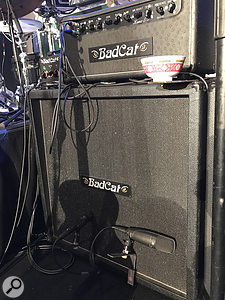 The combination of a Shure KSM32 and Audix i5, mounted on Z-bars on the bottom two cones of Wilson’s guitar cabinet, allow Bond to shape the FOH guitar sound.Using venue-supplied sound systems means lots of variety in sound-system quality, and even with tour contract riders specifying what the system must be able to do, and verifying what is going be in the venue when advancing the show prior to the gig, ‘less-than-perfect’ systems and systems with problems are occasionally encountered. There are times when Bond needs to insist that problems are taken care of by the venue to meet contract terms, and times when it’s quicker and easier for him to do what he can do with equipment he is carrying in order to deliver the best possible sounding show for the fans. Waiting too long for fixes delays soundcheck, and in order to get to the next city in time and meet venue curfew restrictions, the show must start on time.
The combination of a Shure KSM32 and Audix i5, mounted on Z-bars on the bottom two cones of Wilson’s guitar cabinet, allow Bond to shape the FOH guitar sound.Using venue-supplied sound systems means lots of variety in sound-system quality, and even with tour contract riders specifying what the system must be able to do, and verifying what is going be in the venue when advancing the show prior to the gig, ‘less-than-perfect’ systems and systems with problems are occasionally encountered. There are times when Bond needs to insist that problems are taken care of by the venue to meet contract terms, and times when it’s quicker and easier for him to do what he can do with equipment he is carrying in order to deliver the best possible sounding show for the fans. Waiting too long for fixes delays soundcheck, and in order to get to the next city in time and meet venue curfew restrictions, the show must start on time.
Distorting subwoofer drivers are something Ian can’t fix himself, for example, so the venue has to find matching replacements for each sub array, without delaying soundcheck too much. Main floor speakers not covering the auditorium with sound evenly enough are something that would be a more difficult fix for the venue (regardless of contractual obligations), so at a recent show Bond’s quick thinking resulted in a spare pair of d&b Y10Ps (carried to be surround speakers, as discussed earlier) being repurposed as ground-floor mains — incredible sound and coverage from such small speakers, and an amazingly compact emergency Plan B to have available! This is extra work, scrambling and hassle for Bond, but it shows his respect for the band’s sound and vision, and the ticket-buying audience. Experience has taught him which battles to fight and which to take care of himself (regardless of who is really responsible). It has also given him the ‘assertive yet professional’ communication skills to make sure solutions are found by the people who need to find them.
This band and their crew are a perfect example of a tour where great musicians and a great crew make new and unknown venues work, look and sound great. They use technology to enhance the concert experience, but they don’t rely on it, and are perfectly capable of putting on a killer show without it.
The Name’s Bond...
The right sound engineer can make or break a show by either gluing each musician’s sounds together into the work of art the band envisage, making them indistinguishable from each other, or ripping them apart into disjunct elements. Wilson and Bond are a perfect pairing; it’s obvious that Bond understands Wilson’s aesthetic, producing a huge homogenous sound with every little detail audible, respecting and faithfully translating the vast array of textures and dynamics coming from the stage into the concert venue.
Bond describes how he got his start in the industry: “I went to university for an electronic engineering course, but left early to work for a repair and service engineer who also had a PA system he used for various local and national acts. After a while I ended up taking over his PA/sound engineer duties. Then I started buying gear, because I found that getting the right gear for what I was doing was difficult, and I ended up doing small touring shows in the ’90s. Since then I’ve worked for bands including Anathema, Blackfield, Dream Theater, King Crimson, The Levellers, Marillion, NoMan, and Porcupine Tree.”
All the mics used on this tour belong to Bond, and on European legs much of the carefully chosen PA equipment they carry is also his own. A particular fan of Midas and d&b, he is a true professional who really cares about how the artist’s musical and sonic vision is presented to every member of the audience, every night.
A Critical Ear?
Steven Wilson is a respected mix engineer in his own right. Does this mean that he is highly critical of, and wants his influence and signature stamp on, the FOH mix? Apparently not, according to Bond: “We do have conversations, but he’s generally hands-off. The most common discussions we have are usually about an effect here or there.” Not only does Wilson surround himself with great musicians whom he knows will deliver his musical vision in the studio and on stage, but he does the same with his technical crew.
Having observed a soundcheck, it’s clear to me that there is mutual respect between the musicians and all the crew. On stage are true musicians who want to push themselves, and deliver a captivating performance every night — and to do that they trust Bond to deliver their performance to the audience. In fact, during soundcheck, bass player Nick Beggs even took time to discuss bass sound options for part of a song with Bond, to see which sound from his bass rig worked best in the house mix.
With the frequently changing textures and dynamics of the music, it is surprising that Bond takes an entirely manual approach to mixing the show: “I’m not using any scenes, recalls or automation. Everything is mixed in real time, and tapped in on the fly.” Despite the features available on modern digital mixers, he’s still more comfortable being as hands-on as possible, and in full control of his performance on the mixer.
Drum Miking
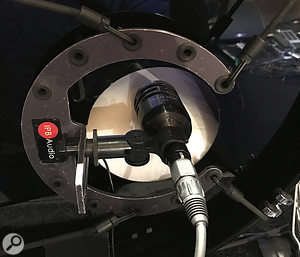 A Kelly SHU shockmount holds the Audix D6 kick-drum mic in place.The kick-drum sound is a combination of an older model Shure SM91 inside the drum, and an Audix D6 suspended so the diaphragm is just inside the hole in the resonant head. Instead of using a mic stand, a Kelly SHU kick-drum shockmount holds the D6 in place. This suspension mount holds the mic more securely than a stand, looks less cluttered and doesn’t take up floor/riser space.
A Kelly SHU shockmount holds the Audix D6 kick-drum mic in place.The kick-drum sound is a combination of an older model Shure SM91 inside the drum, and an Audix D6 suspended so the diaphragm is just inside the hole in the resonant head. Instead of using a mic stand, a Kelly SHU kick-drum shockmount holds the D6 in place. This suspension mount holds the mic more securely than a stand, looks less cluttered and doesn’t take up floor/riser space. A D6, inside and very close to the top head of the ‘timpani’ tom drum.
A D6, inside and very close to the top head of the ‘timpani’ tom drum.
Double-miking often involves using each mic to provide different, contrasting components of the sound source. To achieve best results, sometimes significant EQ is necessary. Bond’s EQ on the SM91 inside the drum is a good example of this — he uses an extreme boost of the lows to provide a lot of fundamental tone and boom to add to the D6 at the hole, which provides much of the body and click of the sound.
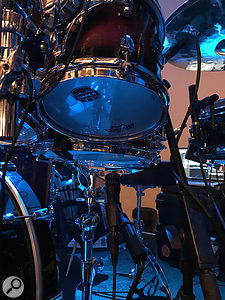 An i5 under one of the snare drums, and an SCX1-HC miking the hi-hat from the underside.
An i5 under one of the snare drums, and an SCX1-HC miking the hi-hat from the underside.Two snare drums are miked top and bottom with Audix i5 cardioid dynamic mics, while Audix MicroD hypercardioid condenser clip-on mics capture the close-up sound of the toms, each positioned a couple of inches above and just inside the top rim of each drum. Of particular interest is a large ‘timpani’ style tom to the side of the drummer.
For a massive, larger-than-life, beefy and punchy sound, an Audix D6 (one of the beefiest kick drum mics around) is positioned inside the drum (which has no bottom head) just a few inches below the top head.
Slightly less conventionally, the two hi-hats are miked from below, using Audix SCX1-HC small-diaphragm hypercardioid condensers, on mounts attached to the hi-hat stands.
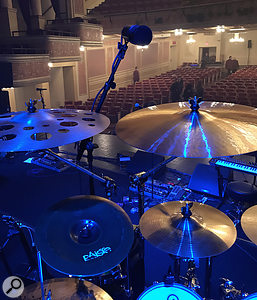 An Audio-Technica 4050 close over one of the banks of cymbals.A pair of overhead Audio-Technica AT4050 large-diaphragm condenser mics take care of a bank of five cymbals on each side, positioned relatively close to the highest cymbals, about 30cm (12 inches) over them, for maximum isolation. Every other drum set instrument being individually miked, the overheads are positioned to focus on cymbal pickup, and not optimised for pickup of the entire drum set.
An Audio-Technica 4050 close over one of the banks of cymbals.A pair of overhead Audio-Technica AT4050 large-diaphragm condenser mics take care of a bank of five cymbals on each side, positioned relatively close to the highest cymbals, about 30cm (12 inches) over them, for maximum isolation. Every other drum set instrument being individually miked, the overheads are positioned to focus on cymbal pickup, and not optimised for pickup of the entire drum set.Keyboard Setups
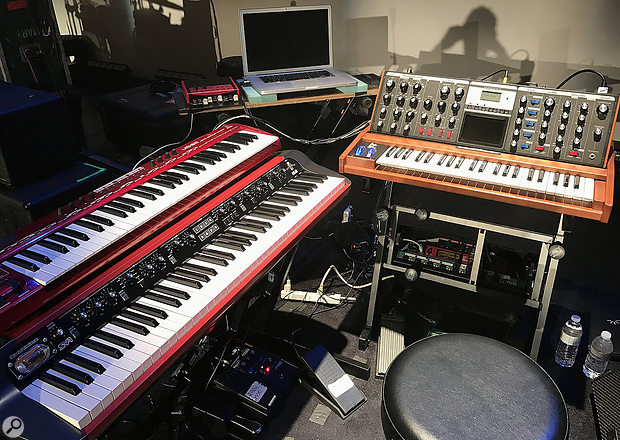 Adam Holzman’s keyboard rig, including a Korg SV1, Moog Voyager and a laptop running Apple’s MainStage software.
Adam Holzman’s keyboard rig, including a Korg SV1, Moog Voyager and a laptop running Apple’s MainStage software.
Wilson’s and Adam Holzman’s keyboard rigs are controlled by Apple’s MainStage software, an application in which, amongst other things, scenes can be stored and switched between, automating MIDI patch changes on attached hardware instruments, software instruments and effects plug-ins running inside MainStage. In addition to switching sounds, it enables hardware controllers (either knobs, wheels or foot pedals, for example) to be easily routed to different parameters within a hardware or software instrument, to change the sound in real time.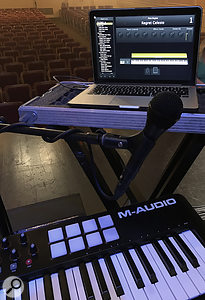 Steven Wilson’s OM7 vocal mic and MainStage rig.
Steven Wilson’s OM7 vocal mic and MainStage rig.
Holzman’s rig includes a Korg SV1 synth, used mainly for piano, Rhodes and Wurlitzer sounds. The SV1 is connected to ring-modulator, wah-wah, and delay pedals. A Moog Voyager is connected to a delay pedal, for smooth analogue synth solos, and a Behringer U-Control controller keyboard is connected to MainStage software synths and a Hammond XM-2 organ module (plus drawbar controller). To reduce stage and truck-pack footprints, Wilson and Holzman rely on faithful digital emulations of the large, heavy (and potentially unreliable) analogue instruments such as Hammond organs, Mellotrons, and Leslie cabinets.
Wilson’s smaller keyboard rig features an M-Audio Oxygen 61 controller keyboard triggering software synths and samples from his dedicated MainStage laptop.
Vocal Processing
Bond uses several processors in the Pro 2 console to help Wilson’s vocal penetrate and sit comfortably with the entire band’s sound, without it becoming shrill, piercing, or overly on top of the mix. He describes his approach as: “Minimalistic. For dynamics, I use the onboard Dynamic EQ Processor — basically a BSS901! The first filter is a low shelf, dropping off popping and proximity issues. Next is a broadband comp, which is usually bypassed — I only use it when headroom is an issue on house rigs. My own d&b rigs never have issues with that! The third and fourth filters take care of de-essing when required.”
These techniques mean that he doesn’t need huge amounts of traditional EQ to give the vocal the punch and cut it needs. Typically this means a few dB of attenuation in the lows and low-mids to counter the proximity effect caused by Wilson being right on the mic, a slight and narrow reduction of some nasal characteristics around 1kHz, and a very small attenuation around 4kHz to smooth out some of the edge of the OM7 microphone’s biggest presence peak, delivering a smooth vocal sound to the audience.
Pedal Power
 Steven Wilson’s guitar effects (with opening act Bruce Soord’s pedals in front).Adding to the varied and complex palette of sounds coming from the stage are many guitar and bass pedals and effects units. As mentioned in the main text, the guitar cabinets are miked with an i5/KSM32 combination.
Steven Wilson’s guitar effects (with opening act Bruce Soord’s pedals in front).Adding to the varied and complex palette of sounds coming from the stage are many guitar and bass pedals and effects units. As mentioned in the main text, the guitar cabinets are miked with an i5/KSM32 combination.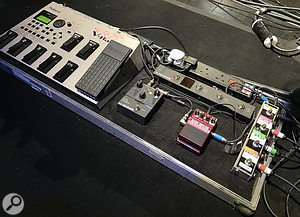 Dave Kilminster’s pedalboard.
Dave Kilminster’s pedalboard.
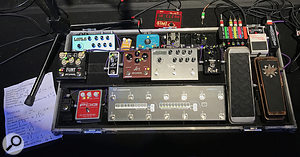 Bassist Nick Beggs’ pedalboard.Nick Beggs’ bass rig is connected via its DI out, and both his Chapman Stick and Wilson’s bass rigs are DI’d using Klark Teknik DI100 boxes.
Bassist Nick Beggs’ pedalboard.Nick Beggs’ bass rig is connected via its DI out, and both his Chapman Stick and Wilson’s bass rigs are DI’d using Klark Teknik DI100 boxes.

